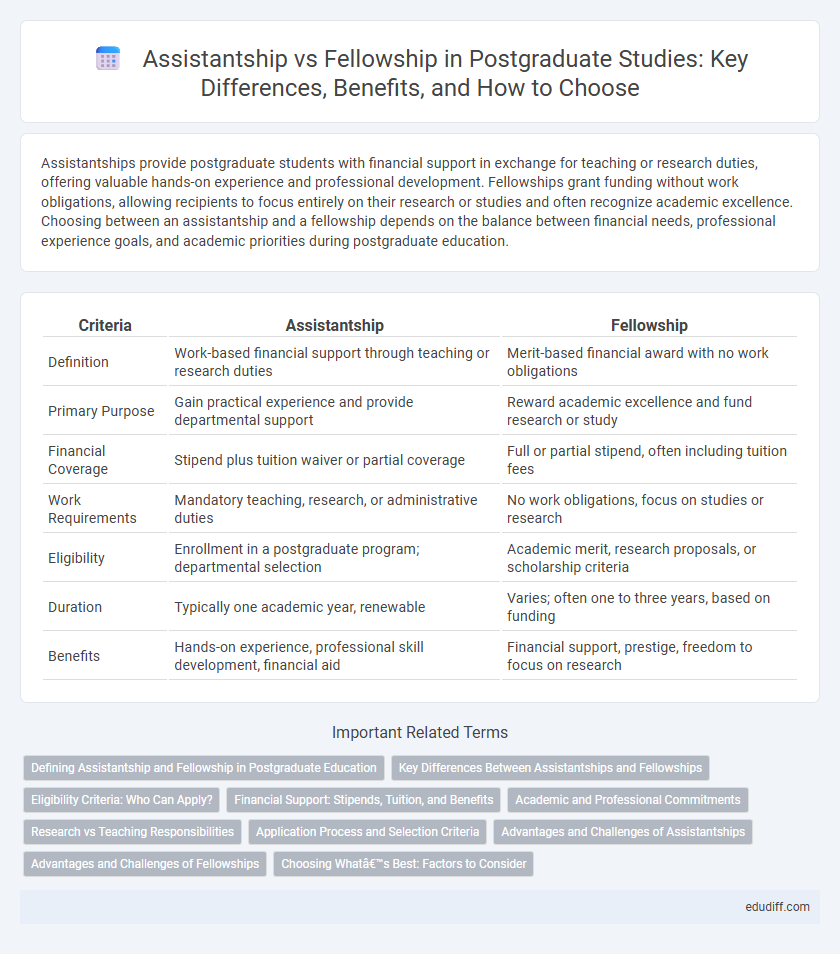Assistantships provide postgraduate students with financial support in exchange for teaching or research duties, offering valuable hands-on experience and professional development. Fellowships grant funding without work obligations, allowing recipients to focus entirely on their research or studies and often recognize academic excellence. Choosing between an assistantship and a fellowship depends on the balance between financial needs, professional experience goals, and academic priorities during postgraduate education.
Table of Comparison
| Criteria | Assistantship | Fellowship |
|---|---|---|
| Definition | Work-based financial support through teaching or research duties | Merit-based financial award with no work obligations |
| Primary Purpose | Gain practical experience and provide departmental support | Reward academic excellence and fund research or study |
| Financial Coverage | Stipend plus tuition waiver or partial coverage | Full or partial stipend, often including tuition fees |
| Work Requirements | Mandatory teaching, research, or administrative duties | No work obligations, focus on studies or research |
| Eligibility | Enrollment in a postgraduate program; departmental selection | Academic merit, research proposals, or scholarship criteria |
| Duration | Typically one academic year, renewable | Varies; often one to three years, based on funding |
| Benefits | Hands-on experience, professional skill development, financial aid | Financial support, prestige, freedom to focus on research |
Defining Assistantship and Fellowship in Postgraduate Education
Assistantship in postgraduate education involves graduate students working part-time in teaching, research, or administrative roles, receiving stipends and tuition waivers. Fellowship provides financial support for postgraduate students based primarily on academic merit or research potential, often without work requirements. Both assistantships and fellowships aim to fund graduate studies but differ in obligations and funding sources.
Key Differences Between Assistantships and Fellowships
Assistantships typically require graduate students to perform teaching or research duties in exchange for tuition remission and a stipend, while fellowships provide merit-based financial support without work obligations. Assistantships often offer practical experience and networking opportunities within the academic department, whereas fellowships emphasize independent research or academic excellence. The funding source for assistantships is usually departmental budgets, whereas fellowships are often funded through external grants or university-wide scholarship programs.
Eligibility Criteria: Who Can Apply?
Graduate students with strong academic records and research experience are typically eligible for assistantships, which often require enrollment in a specific program or department. Fellowships usually target outstanding candidates based on merit, academic excellence, and potential for significant contribution, sometimes requiring separate application processes. International students may qualify for both, but eligibility varies by institution and funding source.
Financial Support: Stipends, Tuition, and Benefits
Assistantships typically provide financial support through a combination of stipends, tuition waivers, and health benefits, often requiring students to perform teaching or research duties. Fellowships offer competitive stipends and full tuition coverage without work obligations, allowing recipients to focus entirely on their studies or research. Both funding options significantly reduce postgraduate financial burdens but differ in their expectations and benefit structures.
Academic and Professional Commitments
Assistantships typically require postgraduate students to engage in teaching, research, or administrative duties, providing hands-on experience that complements their academic learning while supporting their financial needs. Fellowships often offer financial support with fewer direct work obligations, allowing students to focus more intensively on their research and professional development without the time constraints of employment. Balancing assistantship duties can enhance practical skills and time management, whereas fellowships generally promote deeper scholarly pursuits and uninterrupted academic progress.
Research vs Teaching Responsibilities
Assistantships typically involve teaching responsibilities such as leading discussion sections, grading, and assisting professors, providing hands-on instructional experience for postgraduate students. Fellowships primarily focus on research, offering recipients financial support while allowing them to concentrate on independent or collaborative scholarly projects without teaching duties. Both opportunities enhance academic development, but assistantships prioritize teaching skill-building whereas fellowships emphasize advancing research expertise.
Application Process and Selection Criteria
Assistantship applications typically require submission of academic transcripts, letters of recommendation, and a statement of purpose, emphasizing relevant experience and research interests. Fellowship selection criteria prioritize outstanding academic achievements, leadership potential, and alignment with the fellowship's thematic focus, often necessitating a detailed research proposal. Both processes evaluate candidates on academic excellence, but assistantships may weigh departmental needs and teaching aptitude more heavily.
Advantages and Challenges of Assistantships
Assistantships in postgraduate studies offer practical teaching or research experience alongside financial support, fostering skill development and academic networking opportunities. Challenges include balancing workload with coursework and managing time efficiently to meet both assistantship responsibilities and degree requirements. While assistantships enhance professional growth, the demand on time and energy may impact academic performance if not well-managed.
Advantages and Challenges of Fellowships
Fellowships offer substantial financial support and often provide opportunities for interdisciplinary research, enhancing academic and professional development during postgraduate studies. These programs typically include access to institutional resources and networking with leading experts, fostering a collaborative research environment. Challenges of fellowships may include competitive selection processes and obligations such as teaching or administrative duties that can limit research time.
Choosing What’s Best: Factors to Consider
When deciding between an assistantship and a fellowship in postgraduate studies, evaluating financial support, workload, and professional development opportunities is crucial. Assistantships often provide a stipend along with teaching or research responsibilities that enhance practical experience, while fellowships generally offer more funding with fewer obligations, allowing greater focus on research. Consider your career goals, time management preferences, and the level of mentorship required to determine which option aligns best with your academic and professional aspirations.
Assistantship vs Fellowship Infographic

 edudiff.com
edudiff.com